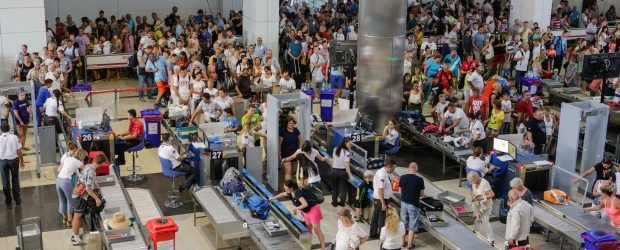The Government of Canada, World Economic Forum, and other global partners are testing a new concept in border security, which will let travellers digitize their personal information and share it with airport and government authorities before traveling.
Developed in collaboration with Accenture, the Known Traveller Digital Identity prototype was launched at this week’s World Economic Forum (WEF) in Davos and uses blockchain and advanced biometrics to share personal data with public and private-sector entities. They’ll be piloting it this year, according to Dave Telka, managing director of Accenture Canada Health and public service digital lead.
“This is a great example of digital at work, disrupting traditional models,” he says.
Canada is working with the Netherlands and the WEF to test the prototype. In a statement, Marc Garneau, Minister of Transport of Canada, showed his support for the initiative and said air travel will greatly improve from technological advancements. The goal is to have the technology fully operational at airports by 2020, according to the WEF’s report. By 2030, international air arrivals are expected to reach 1.8 billion passengers, a 50 per cent increase from the 1.2 billion arrivals recorded in 2016. And while the WEF and others involved in the concept’s design hope to see it scale rapidly, several questions remain unanswered.
Little is known about the specific distributed ledger technology the prototype is powered by right now, although the WEF report refers to Hyperledger – an open source platform for blockchain technology released in 2015 – when it comes to examples of permissioned public ledgers. But Accenture didn’t confirm that’s the platform to be used for the pilot.
“It’s a vanilla blockchain right now,” says Carl Sharpe, senior principal at Accenture advanced analytics on artificial intelligence. “It could be a different distributed ledger later on.”
The prototype is currently built on a permissioned public ledger concept, where a consortium gives access to specific people, or nodes, to control the system and validate activity on the blockchain. Travelers build up trust in their digital identity by adding attestations to their record, such as a proof of citizenship, educational degrees or proof of vaccinations. These are verified by the trusted nodes, explains Sharpe.
He adds the Immigration, Refugees and Citizenship Canada, Canadian Border Services Agency and Transport Canada are involved in discussions about implementation.
Cost estimates for implementation are also unknown. Those numbers won’t be available until the project begins scaling up, says Telka.
Staying relevant while scaling
Building on the distributed ledger concept provides the project flexibility, says Sharpe.
“As we iterate on this, if parts of the technology don’t hit two or three key requirements, we’ll be able to remove and plug and play a new technology stack into it.”
The prototype has identified five pain points for travellers, which it aims to improve: visa applications, bookings, security screenings, departure gates, and border security. Having these pain points already identified will make it much easier to develop technologies that target them, says Telka.
Not necessarily about speed, but about security
A few individuals at this year’s WEF were able to test parts of the Known Traveller Identity. To start, they downloaded an app, uploaded their passport information and confirmed their biometric data with a fingerprint scanner, explains Sharpe. Once an identity got confirmed through a trusted adviser (in Canada, that could be the CBSA) that person got a stamp on their known traveller identity. That data can then theoretically be used for pre-bookings and security checkpoints.
The technology is sure to disrupt and eventually simplify certain parts of cross-border travel, says Telka, but it’s most likely to shine from a security perspective.
“It’s not about expediency, it’s about verification of who is going through the airport and traveling to other countries,” he says.


